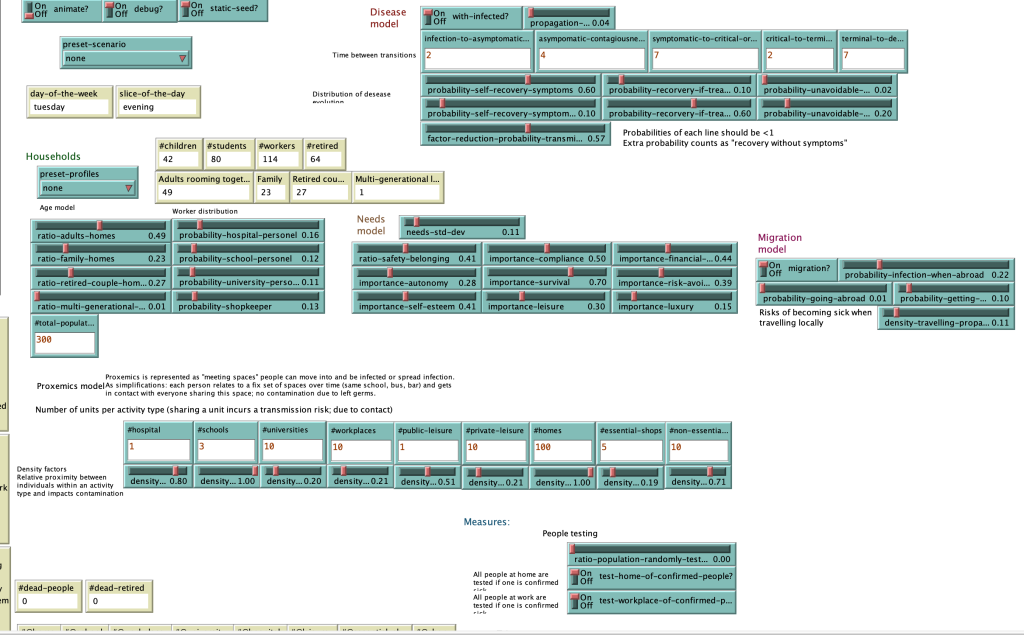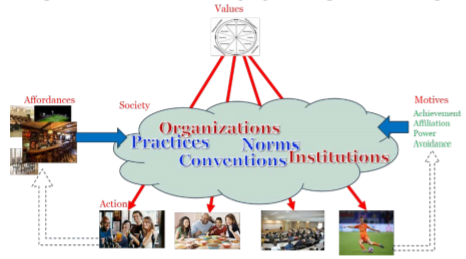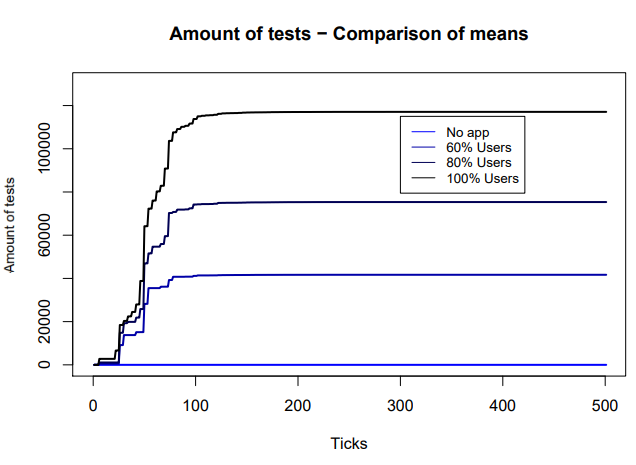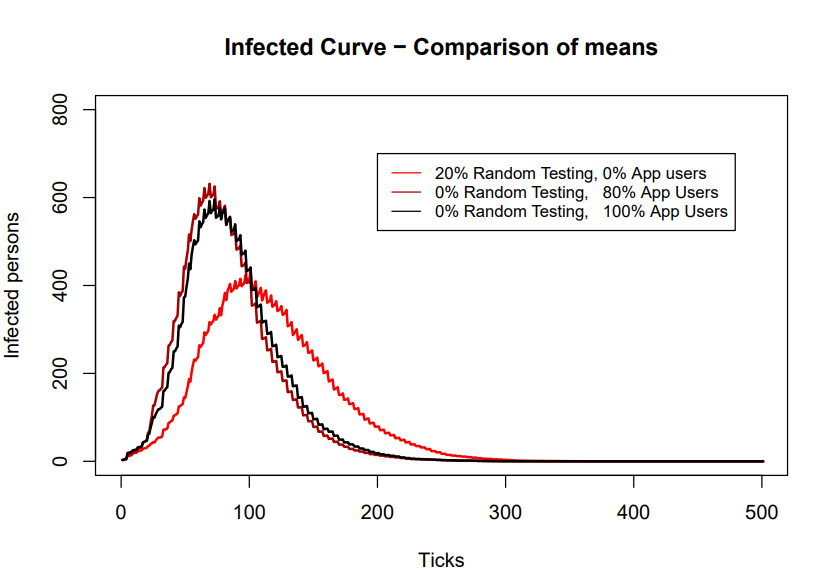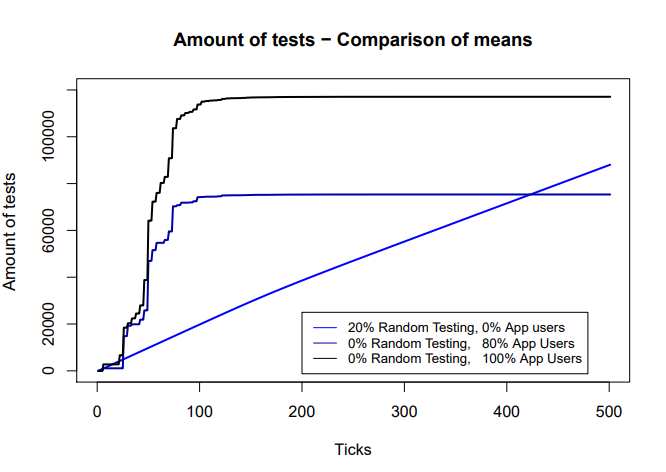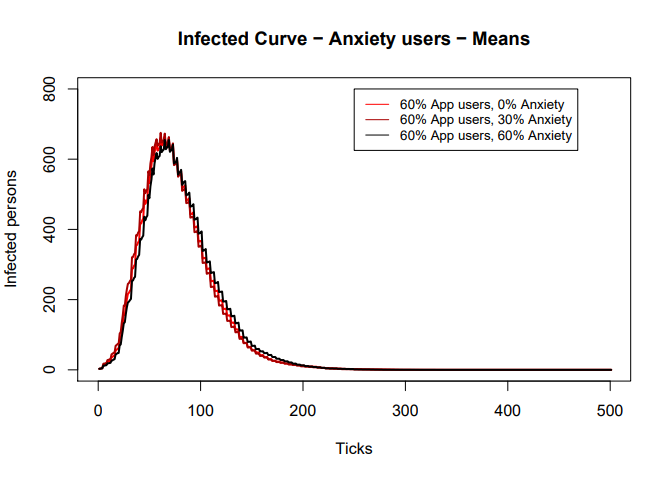PRE2019 4 Group10
Project Robots Everywhere - The Corona App
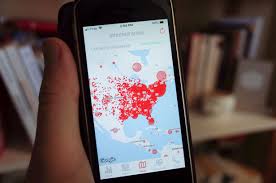
In these turbulent times, Corona has been affecting our daily lives. It has been such an impactful disease, that the government had to come up with a solution on how to create awareness of those who have had COVID-19 and those who do not. One of the most widely discussed option in the Netherlands would be a Corona Mobile Application (Corona App).
However, there is still a lot of discussion surrounding this app and its applications. The goal of the Corona App is to give an insight into the current spread of the virus, such that regulations can be implemented or improved, based on this spread. In this project, however, the focus will lie solely on the effectivity of such an app and it’s requirements for this. Effectivity will be the focus because if an app can’t be efficient enough, it would be useless to implement. This is also the reason why there will be no focus on other social questions such as privacy.
Based on literature reviews, simulations, and user-testing, these requirements will be listed and a proposal will be formed about the effectivity of such an app.
Groupmembers
| Name | Student Number | Study |
|---|---|---|
| Ezra Leeuwenhage | xxxxx | xxxxx |
| Paulien Teuwen | 1337904 | Industrial Design |
| Yorn Thijssen | xxxx | Industrial Design |
| Ries van de Ven | xxx | Industrial Design |
| Kim Wintraecken | xxx | Industrial Design |
Problem statement and objectives
TThe issue capturing global attention in recent months is the Covid-19 pandemic, causing great disruption throughout the world in both in terms of health care and economy. Many governments have since the outbreak opted for an approach to combat the virus through limiting all social interactions within society (commonly referred to as a lockdown), putting a halt to its spread at the cost of national economy. In the long term this approach is not sustainable however, leading to the need to find ways to reduce restriction on social interaction in all aspects of society without losing grip of the spread of the virus. To this end, the Dutch government has suggested the nation-wide employment of an application designed to predict/ detect infection with Covid-19 of civilians, enabling them to accurately manage the virus’s impact on society without the need for a type of lockdown. The need for such an app is still being questioned, since it brings a lot of difficulties with it, regarding the violation of the Dutch privacy legislation.
However, there would be no need to check all social implications in detail, if such an app is simply not efficient enough to contribute to the curbing of the virus. Since in this scenario, it would be fruitless to implement such an app. This project will shed light on the requirements that need to be met, to make the app efficient enough to combat the Covid-19 pandemic.
The objectives of this project will be to determine through literary research what the relevant requirements are to the problem and what exactly the desired effectiveness of the application is in order to meet its requirements. Finally, the objective of practical research done thereafter will be to determine what type of implementation of the app satisfies the requirements set by the results from literary research.
Who are the users?
Users:
- Smartphone users
- Dutch citizens (who own a smartphone)
Other stakeholders:
- Government
- Public health authorities
- Hospitals
- Healthcare personnel
- Outbreak Management Team
What do they require?
Users require:
- Safety check
- Did I come in contact with anybody who is registered with the virus, or who has recovered from the virus?
- Raise own awareness of spreading possibilities
- How can I prevent the spread of the virus myself?
- Current information about situation
- News-updates
- Latest governmental conferences
- Current national measurements
- Healthcare issues and prevention methods
- How can I protect myself?
- What to do if I need to leave the house for necessity?
Stakeholders require:
- Additional data about the spread of virus
- New data can be used to make estimations or inform the country
Approach, milestones, and deliverables
Approach
Solving the problem around the corona app has a difficult set of objectives: first the group should evaluate the existing research about the corona app and the current simulations that exist regarding the efficiency of such an app. Next, different simulations must be compared an analyzed to specify a list of requirements and parameters. Based on these requirements, a new simulation will be created that solely focusses on the efficiency.
These results should confirm or deny earlier research and the goal is to determine if a corona app would be suitable to achieve the combat of the virus.
Milestones
A certain milestone is composing the requirements for the corona app. Choosing the requirements depends on the research and the type of app. The requirements must ensure the app is efficient. Another milestone would be making the simulations for testing.
Week number: Tasks
| Week 1: | Background study |
| Week 2: | Requirements |
| Week 3: | requirements and parameters |
| Week 4: | requirements and parameters. Comparing different existing simulations. Contacting different organizations to discuss their results |
| Week 5: | Start making simulation. Continue research in requirements and parameters |
| Week 6: | Testing (survey) & Simulation testing |
| Week 7: | Continue Simulation |
| Week 8: | Final presentation and demo (recorded video) |
Deliverables:
The output of the project should be an analysis of a simulation made to map the effectiveness, as well as a proposal containing the requirements that need to be met. Furthermore, a wiki page containing all information on the process of the project and the final presentation of week 8 will be delivered.
Who is doing what?
To create a full detailed planning for the hole course is difficult, especially in situations like these where we do not know what we are capable of and things can change every week. Therefore, we have chosen to divided tasks after each meeting or every week just like in an OGO project. These assigned tasks will be published weekly on the wiki in a table. However, to keep track on the schedule, some team members will be assigned to have a leading role over a part in the project.
Furthermore, because we are doing the project like an OGO project, we also assigned roles for Chairman and Minute taker for each meeting. This will be according to the following schedule:
Meetings per week:
Monday - 09:30
Thrusday - after tutoring session
Date Chairman Minute taker
| Date | Chairman | Minute Taker |
|---|---|---|
| 27/04 | Kim | Ries |
| 30/04 | Ries | Yorn |
| 04/05 | Yorn | Ezra |
| 07/05 | Ezra | Paulien |
| 11/05 | Paulien | Kim |
| 14/05 | Kim | Ries |
| 18/05 | Ries | Yorn |
| 21/05 | Yorn | Ezra |
| 25/05 | Ezra | Paulien |
| 28/05 | Paulien | Kim |
| 01/06 | Kim | Ries |
| 04/06 | Ries | Yorn |
| 08/06 | Yorn | Ezra |
| 11/06 | Ezra | Paulien |
| 15/06 | Paulien | Kim |
| 18/06 | Kim | Ries |
Weekly hours
Progress per Week
Week 1
Notes on literature
Week 2
After meeting with our tutor adjustments to the planning above were made. In summary, the project was scaled down to a concise and reachable set of goals and tasks and the emphasis for the first few weeks was shifted towards setting valuable, precise and well-founded requirements for an implementation of the corona app. Details of that particular meeting have been recorded here:
File:Notities conference call 1.pdf
- insert progress by Paulien (simulation software viability)*
Week 3
The requirements to be set were discussed in meeting 4 (File:Minutes 04 05 20.pdf) and these were the main results in terms of type of requirements to be investigated en quantified: - Users & habits (of dermatological application software) - Combatting virus spread
Other useful leads in advancing the project that were explored: - Viability and reliability of employment of simulation software (by TU Delft) for testing effectiveness of corona app
More detailed information on the requirements can be found in the minutes and the research below.
File:Bestrijding van verspreiding.pdf
Week 4
File:Hw kim simulation simulation delft.pdf Analysis simulation model Delft ASSOCC
The ASSOCC model (Agent-based Social Simulation for the COVID-19 Crisis), is a model that has specifically been designed and implemented by European researchers from Umeå University, TU Delft, Malmö University, Utrecht University, Caen University and Stockholm University to address the societal challenges of the COVID-19 pandemic.
What exactly is it? [1]
This model uses “corona in Simcity” approach to study individual and social reactions to the containment policies. It is a tool for decision makers to explore different scenarios and their effects. It is not a model to generate predictions. It simulates the behavior of a synthetic population given a set of policies (for example when in a lock-down or voluntary isolation). It enables to study the effects on both the spread of the contagion and on how people can be expected to react to the policies (e.g. potential violations or workarounds).
What answers does it provide? [1]
It models both the possible effects on the spread of the coronavirus and the socio-economic effects of the policies, providing possible answers to:
• How might policies based on achieving drastic behavioral change go wrong?
• How might one work with existing social norms and habits to effectively limit virus spread (what will work with populations and what will not?)
• How might we reintroduce people who have recovered from the disease back into society to help others and revive the economy without this leading to social division and a general breakdown of social distancing?
• What are the possible dangers of social polarization between vulnerable older people and the young who want to get together, how might we keep younger people “on board”, how might we stop them losing contact with other generations?
• For particular groups within societies, at particular times of year or day are there safe gathering activities with very low risk of contagion? Are there practices that are particularly dangerous.
• What new social practices might we develop that allow life in a world susceptible to waves of new infection (e.g. red and blue teams in hospital so there is no overlap)?
• Timing and consequences of lifting the restrictions
How does it work? [1]
ASSOCC is made in NetLogo. It is based on a set of artificial individuals, each with given needs, demographic characters, and attitude towards regulations and risks. All the agents decide each time what they should be doing and because of this, many different possible effect of policies can be analyzed.
This figure is a screenshot of the parameter setting in the NetLogo model. (ASSOCC, 2020)
More information about what each parameter means can be found in the pdf: “Hw Kim simulation delft’.
The framework is based on the fact that individuals have to balance their needs over many contexts.
The following image shows how people manage this balancing act in their daily life:
More information about this image can be found in the pdf: 'Hw Kim simulation delft’.
Agents selecting an action: [1]
1. an agent creates a list of all possible places (gathering-points) it can go with different motivations = an action this list is based on their current age, time of day, day in week, parameters set in the model
2. for all these actions, the global expected effect on the needs is calculated (summing over the expected effects x the desire for each main need)
3. the action that satisfied the highest number of needs is selected to be acted upon
after all agents have moved to the location where they want to execute their action, the actions get executed, and the needs get updated
Track and trace apps [2]
ASSOCC has looked at the policy of implementing the ‘corona app’ into society. In their scenario, they assumed a perfect app aligned with all functional, legal and ethical requirements. They studied the effectiveness of such an app by performing 3 experiments:
1. The effect of the app depending on different percentages of the population using the app
2. Comparing the effect of using the app with that of random testing a percentage of the population
3. Effect of the app depending on the characteristics of the users (percentage of risk-avoiding agents that use that app)
The following conditions were used:
• Percentage of app users = (0%, 60%, 80% or 100%)
• Percentage of app users = 0.0 and percentage of population tested randomly daily = (0% or 20%)
• Percentage of app users = 60% and percentage of risk avoidance app users = (0%, 30% or 60%)
Results [2]
Experiment 1: Differing amounts of population using the app
According to ASSOCC, using the app results in a lower infection peak. However, the differences are not significant in a test using 15 randomised runs for each setting, as depicted in curve1.png comparing the settings for no app users, 60% app users, 80% app users and 100% app users, with a population of 1000 agents.
However, as depicted in curve2.png, increasing the number of users results in a sharp increase of testing given that all those that are alerted of being in contact with an infected agent will need to be tested (or required to quarantine themselves).
These results left ASSOCC with the question how does the usage of the app compare with a similar amount of random testing. This gave the basis for experiment 2.
Experiment 2: comparing tests performed through app with random testing
According to ASSOCC, random testing raises infection awareness even when the tested agent had no reason to suspect infection. The differences on number of infected agents under different conditions is shown if curve3.png
Experiment 3: effect of the type of app users.
Next, ASSOCC hypothesized that the people who are most likely to use the app are probably those that are more risk averse. However, in initial tests, they were not able to see a significant difference under this condition.
Conclusion: [2]
The effectiveness of tracking and tracing apps on lowering the number of infected agents is limited and lower than that of random testing. The use of the app results in a sharp increase on the number of agents that need to be tested, which may be above the capacity available in the system.
ASSOCC therefore concludes from this data that the app (with around 60% use) makes no significant contribution to a virus-free Netherlands.
Results show that by themselves these apps have none or minimal effect on the spread of the virus. Besides all legal, constitutional and ethical issues, their use may lead to a false feeling of security which ultimately can contribute to a second wave of the contagion [3].
Other studies, based on large scale mathematical models of epidemics show the opposite effect. I.e. according to those studies, track and trace apps do have a positive effect on the containment of the virus [3].
It is important to compare these types of studies and see why they lead to different results.
The major difference between the ASSOCC model and those used by many epidemiologists is that ASSOCC has a simulation based on human behavior which is used together with the epidemiological model [3].
The important difference between ASSOCC model and other models, lies in a number of specific properties of the corona virus:
1. The time between becoming infected and possibly showing symptoms is quite long. In an epidemiological model, this is translated by giving a parameter a different value. However, when looking at how many interactions people have, and with which other people, probabilistic model in a mathematical model can be used that divides the interactions uniformly or normally over all possibilities. That differs somewhat from reality if the interval in which this happens is short, but not so much that it disturbs the results a lot. However, if that interval becomes longer, the mathematical model is no longer correct. This is often seen in macroeconomic models: they do reasonably well in normal situations, but in crisis situations people do not behave according to expectations and the deviations are too great to make those models even of value.
2. Another issue is the skewed age distribution of the corona virus infection: relatively many young people are asymptomatic. So they are infected without knowing it and spread (with lower chance, but still) the virus. Because they are not being tested, this distribution continues. Young people also meet more other young people on average, so the contagion can go on for quite some time before being noticed. From the perspective of the track and trace apps, this means that people have already fallen from the contact list that is about a week long. In this way, there are a lot of points along which the virus still spreads despite the use of the app.
3. Demographics and living arrangements are also a determining factor. For example people lives who live in Italy look a little different than in the Netherlands. So the results are slightly different, but the conclusion remains. In the Italian case, the positive effect of testing randomly 20% of the population is even greater than in the Netherlands.
The issues above are not easy to capture in macro level models, as those used in epidemiology. ASSOCC considers the difference between people’s ages, backgrounds, living situation and behavioral motives. Many scientific studies point out that the lack of a human behavior model in the epidemic models is a problem. ASSOCC is one of the few in the world that combines the human models with the epidemic models. It would be nice if a lot more research was done, because then this type of models would improve greatly and there would be more comparative studies.
[1]ASSOCC. (2020, April 20). The simulation. Retrieved from https://simassocc.org/assocc-agent-based-social-simulation-of-the-coronavirus-crisis/the-simulation/
[2] ASSOCC. (2020b, April 21). Scenario: effect of track&trace apps. Retrieved from https://simassocc.org/scenario-effect-of-tracktrace-apps/
[3] Dignum, F. (2020, April 19). Mathematics vs. social models: how to understand the sociology of corona virus spread. Retrieved from https://simassocc.org/assocc-agent-based-social-simulation-of-the-coronavirus-crisis/news-and-publications/
Week 5
Contact App developers
In this research several models and simulations about the effectiveness of a corona app are investigated and studied. Before the idea of implementing such a track and trace corona app these kinds of simulations were not available yet, so there could not really be stated anything about the effectiveness of such an app. But even though this was not known, app developers already started with bringing ideas about how they could help with an app during this crisis.
On the 11th of April the Dutch government made a call for companies and experts to think about the development of apps in the approach against corona virus. This proposal had to be in of three categories:
An app that to determines contact between people and notifies when a user was in contact with an infected person.
An app that makes it easier to have contact with a doctor from home.
Any other ideas of an app that could help in the fight against corona.
These companies and experts could submit a proposal until Tuesday 14th of April, 12:00. In total there were more than 750 proposals submitted. Eventually 7 teams were chosen to take part in an ‘Appathon’, a digital event to test and improve the working of these corona apps. According to experts, the apps of these 7 teams best match the approach of the Municipal Health Services (GGD) for doing source and contact research, while at the same time meeting requirements that are set in areas such as privacy, data and information security and ease of use.
All seven teams have been contacted for this research to interview them with questions about their approach and if and how they simulated the effectiveness of their app. Not all seven initiatives responded but the ones that did gave very interesting insights and even provided new research. A summary of each interview is given below.
The DEUS initiative
The DEUS initiative explores and builds AI services to create a positive impact on our future. They combine data, design and artificial intelligence to solve challenging problems elegantly, ethically and efficiently.
Before the call of the government, Deus was already brainstorming about how they could help during this pandemic. When the opportunity of coming with this proposal was there, the whole team threw themselves into this. Because of the three categories in which they could submit their proposal in, the team thought of a wide range of technological possibilities (even using WhatsApp for having easier contact on distance). Specifically for the track and trace app, the team performed a technical audit to analyze worldwide existing solutions. The result of this audit was that they proposed the open source DP-3T protocol which has one major benefit: privacy is guaranteed. The protocol does not save personal information neither does it track location. This criteria for privacy was the most important aspect for proposing this protocol. However, this benefit is at the same time a big disadvantage because the GGD would want to know this information. Another important aspect in proposing this protocol is the fact that it is open source. Deus thinks when it is developed by a community it can eventually be developed to a European Standard of a track and trace app.
During the ‘appathon’ Deus showed how a Dutch version of an application with use of the DP-3T protocol would look and work. The application exchanges a digital handshake with use of Bluetooth. It does so when a user has been within a particular distance for a particular time. This distance and time would be determined by the GGD which has a vision about when risk of contamination is higher. The handshakes would be saved and when a user would be tested positive with the disease, this user gets a code from the GGD and enters this in the application. The app then notifies all the other users who saves a ‘handshake’ with this user in the last 10 or 14 days.
This app would support or automate the way the contact research is done now. Currently, when someone is tested positive, he or she will sit down with someone from the GGD and will make an excel sheet with all the people with whom you remember you have been in contact with in the last 14 days, together with their e-mail and phone numbers. The app would reduce work pressure.
Unfortunately, The DEUS team does not have tested their app on effectiveness, simply because there was no time for that.
Volksgezondheid, M. van. (2020, April 11). Oproep om mee te denken over apps. Retrieved May 18, 2020, from https://www.rijksoverheid.nl/actueel/nieuws/2020/04/11/oproep-om-mee-te-denken-over-apps
Contact Tracing
Effectivness of Contact Tracing
Knowing when contact tracing is effective is of great importance. The probability of detecting every individual contact of an infected person is therefore composed of two factors [1]:
The fraction of the population that uses a smartphone-based contact tracing application or app, i.e., its adoption rate.
Another factor which is determined by the probability with which a smartphone is able to reliably detect a contact.
In order for the device to be reliable in its act, the system needs not to rely on GPS data, since this is not reliable due to its inaccuracy [1]. In [1] the authors proposed to use neighbor discovery (ND) [1]. It is based on the phones emitting and scanning for Bluetooth signals, and a successful reception of an emitted Bluetooth signal by another phone and vice-versa will lead to their mutual discovery. For ND, Bluetooth Low Energy (BLE) will be used, because it is designed for continuously scanning in the background. The main reason why contact tracing apps choose for continual transmission and listening instead of continuous is energy [1]. The energy costs would be higher when using continuous transmission and listening.
Treatment or quarantine of people who have been in contact with each other may be effective because unidentified infected persons are most likely to be found among those people, and efficient because the resources can be directed towards individuals at risk only [3]. In order to get effective quarantining and isolation going and because testing and isolation are expensive, there is a strong need to avoid too many false positives [1].
According to [2], contact tracing using smartphones can considerably reduce the reproduction rate R, even with partial adoption of contact tracing apps. However, according to [1], the adoption of contact tracing apps has to be considerably larger than 60% to contain the spread. Therefore, they believe that next to only smartphone related approaches, approaches other than smartphones need to be pursued in order to reach the highest effectiveness [1].
Looking at effectiveness of contact tracing, the latent period (the time interval between when an individual is infected by a pathogen and when he or she becomes capable of infecting other susceptible individuals) needs to be taken into account. [3] teaches us that, whenever the detection time of an infected person is fixed, a too large latent period (larger than the detection time) results in a situation where every infected person is detected before transmitting the infection, so tracing need not prevent any transmission. Effectiveness may therefore be very sensitive to the latent period, especially if there is little variation [3].
The sensitivity of tracing effectiveness to the latent period and tracing delay may be large, especially in the case of single-step tracing [4, 5, 6]. If the same happens with a small delay, reliability of parameter estimates will be of great importance to establish whether tracing is of any help. If it is only the case with larger delays, it could only be effective if it is done quick enough [3]. In most situations single-step and iterative tracing are almost equally effective. A great difference can only be seen if single-step tracing is not or hardly effective, which is also when the sensitivity to the latent period and tracing delay is largest [3]. A variable detection time would therefore improve the effectiveness of the contact tracing [3].
Looking at the ND approach, there are however a few restrictions when looking at the use of smartphones [1]:
When using larger delays than specified in BLE will further improve the reliability in crowded scenarios where multiple phones are present and send beacons, will accordingly introduce an overhead of a factor of approximately six times the energy spent for transmission.
The use of Android and iOS hardware might force the vary fixed values for parameters during the runtime. Next to that, the device might need to run other Bluetooth related tasks in parallel, so overlap will be happening. Because the device can carry out only one task at a time, some scheduling is needed to resolve this conflict. Smartphones share certain hardware components like radio and/or antenna, which needs to be considered.
There are also other limitations present when looking at the ND approach, which do not necessarily have to do with smartphone use [1]:
Because of the use of wireless signals for distance estimations which is subjected to a distance-dependent attenuation, and on the assumption that the distance can be estimated from the measured attenuation, there may occur several errors.
A smartphone might not me carried on the body.
Bluetooth needs to be persistently granted and the app should be activated.
The ND procedure on smartphones consumes more energy than necessary.
Even though the correct hardware and software may be available to make the ND approach work and reliable, it will always get limited in some way, potentially leading to false positives and/or missed contacts [1].
REFERENCES:
[1] Kindt, P. H., Chakraborty, T., & Chakraborty, S. (2020). How Reliable is Smartphone-based Electronic Contact Tracing for COVID-19?. arXiv preprint arXiv:2005.05625. DOI: https://arxiv.org/abs/2005.05625
[2] Ferretti, L., Wymant, C., Kendall, M., Zhao, L., Nurtay, A., Abeler-Dörner, L., ... & Fraser, C. (2020). Quantifying SARS-CoV-2 transmission suggests epidemic control with digital contact tracing. Science, 368(6491). DOI: https://doi.org/10.1126/science.abb6936
[3] Klinkenberg, D., Fraser, C., & Heesterbeek, H. (2006). The effectiveness of contact tracing in emerging epidemics. PloS one, 1(1). DOI: https://dx.doi.org/10.1371%2Fjournal.pone.0000012
[4] Fraser, C., Riley, S., Anderson, R. M., & Ferguson, N. M. (2004). Factors that make an infectious disease outbreak controllable. Proceedings of the National Academy of Sciences, 101(16), 6146-6151. DOI: https://doi.org/10.1073/pnas.0307506101
[5] Eichner, M. (2003). Case isolation and contact tracing can prevent the spread of smallpox. American journal of epidemiology, 158(2), 118-128. DOI: https://doi.org/10.1093/aje/kwg104
[6] Becker, N. G., Glass, K., Li, Z., & Aldis, G. K. (2005). Controlling emerging infectious diseases like SARS. Mathematical biosciences, 193(2), 205-221. DOI: https://doi.org/10.1016/j.mbs.2004.07.006
Digital Contact Tracing Service
The paper focusses on verifying and improving the impact of tracking based on epidemiological models. It hereby presents an improved decentralized, privacy preserving approach of a digital contact tracing service. This tracing of infectious contacts, digital or not, is an epidemiological tool which will only work and be effective if coupled with the ability to test potentially infected people quickly.
The paper ultimately presents a secure solution for a digital contact tracing service (DCTS) that protects the users’ data and identity from attackers. It does this by proposing the use of Bluetooth. and an elaborate explanation of the working of the application.
Each mobile phone equipped with the DCTS app will advertise so called temporary contact numbers (TCNs) to other phones. These TCNs can be seen as tokens. At the same time, it records and stores the TCNs advertised by other phones. Phones will continuously keep advertising their random TCNs and store any observed TCNs from other phones. Whenever a user is infected; they can agree to upload their advertised TCNs to a server. This only happens after approval from medical authorities. Whenever the server matches tokens, it will distribute a notification that contact with an infectious person has happened.
The following steps will more elaborately discuss how the DCTS app works.
The app activates Bluetooth and generates a key, which it uses to generate a random TCN, the token which will be given to other nearby phones.
The phone will be active with this TCN advertised, such that other devices in range of the user can see the TCN. The TCN is updated after a certain amount of time in order to minimize re-identification of the user. Next to that, the TCNs are only stored for a period of two or three weeks, depending on the status of the virus.
The app stores the observed TCNs and keys from other users.
Whenever the app spotted another TCN, it will be stored, and phones will exchange their tokens.
The patient is confirmed infected and is able to upload the advertised TCNs and keys to a server.
The patient gets the permission by a medical authority to upload the generated TCNs, and keys to a server. The server then regenerates and verifies the patients’ TCNs with the provided keys. For privacy and safety reasons, the server will delete the keys after the verification. The server thus collects newly uploaded TCNs and shuffles their order to avoid the avoid the association of several TCNs to a single user.
A match occurs within the TCNs on the server.
The patient’s TCNs are matched against the encountered TCNs registered on the device of the user during the two- or three-week period. If the app detects a match, the user receives a notification that a potentially infectious encounter has been detected. The notification will recommend actions like self-quarantining. The notified user can also be asked to proceed and provide his or her TCNs to allow a recursive tracing.
Checking whether the user has been in contact with an infected person.
First approach: The user can download all unchecked TCNs stored on the server and check for matches within their own list of observed TCNs. When encountering matches, the app can perform a risk assessment based on exposure time.
Second approach: in order to prevent attacks on the previous method, it is able to check for the number of TCNs that are both in our set of encountered TCNs and in the set of infected TCNs.
Second order tracing
COVID-19 is infectious before people develop symptoms [2, 3]. So, it might be useful to implement second order tracing. Users who get notified because they have been in contact with an infectious person also uploads their TCNs in order to prevent second order spreading.
The DCTS app uses Bluetooth as a means of contact tracing, because Bluetooth detects only real encounters and works indoors as well as outdoors, where GPS and mobile network data is not reliable. The type of Bluetooth which is used is called Bluetooth Low Energy (BLE). The proposed approach uses BLE for detecting devices in range. The authors suggest that the battery is drained by no more than 5% by contact tracing and that in a situation with 100 devices being close to each other, the probability that all devices discover each other successfully within 10 seconds is close to 100%.
In order to optimize BLE, the most beneficial parameters are used. Thereby their contact tracing is carried out at the highest reliability and the lowest possible energy consumption.
Making use of Bluetooth goes along with the fact that Bluetooth advertises the MAC-address of the device. In order to cope with this, the app stops and restarts advertising immediately when updating the TCN, such that the advertised MAC-addresses change at the same time as the TCNs. These changing TCNs keep the user anonymous and complicate tracking.
Looking at the effectiveness of the DCTS app, the authors mention several things. First, there should be psychologists consulted about the exact wording and information of the notification which would be send to the user, in order to achieve the desired effect. The notification includes possible measures which should be taken en thus is crucial for stopping the spread of the virus.
The DCTS is being evaluated together with intervention strategies. The results are being crosschecked using both deterministic and Monte Carlo based model approaches [4]. The modeling substantiates the following:
- The DCTS needs a broad acceptance among the population of more than 70% in order to have an impact to control an outbreak. The authors believe that “this can be achieved by a decentralized, secure and privacy preserving design where the users own their data” [1].
- Tracing only people who have been in contact with confirmed infectious persons might not be enough. Therefor the paper wants to enable both first order contact tracing and additionally second order contact tracing. “Tracing second order contacts increases significantly the number of traced potentially infected people. If every direct and indirect contact stayed in quarantine, a huge percentage of the population would be affected” [1].
“Achieving widespread acceptance and trust among the population is the key factor for any digital contact tracing systems' success. Only if the potential users trust in the app’s privacy architecture, they will actually use and follow the app in their daily lives. Against this background, it is crucial to obtain the endorsement of trustworthy institutions like the data protection agencies.” [1]
A centralized approach would be more efficient and effective than a decentralized approach. However, with the centralized approach the risk of re-identification of affected persons may be greater. Hence why is chosen for a decentralized approach in the paper. To achieve a higher effectiveness, a centralized approach should be chosen.
REFERENCES
[1] ContacTUM Consortium, ITO Consortium: Digital Contact Tracing Service: an improved decentralised design for privacy and effectiveness. April 17, 2020 (Working Paper)
[2] Ma, S., Zhang, J., Zeng, M., Yun, Q., Guo, W., Zheng, Y., ... & Yang, Z. (2020). Epidemiological parameters of coronavirus disease 2019: a pooled analysis of publicly reported individual data of 1155 cases from seven countries. medRxiv. DOI: https://doi.org/10.1101/2020.03.21.20040329
[3] Rothe, C., Schunk, M., Sothmann, P., Bretzel, G., Froeschl, G., Wallrauch, C., ... & Seilmaier, M. (2020). Transmission of 2019-nCoV infection from an asymptomatic contact in Germany. New England Journal of Medicine, 382(10), 970-971. DOI: https://doi.org/10.1056/NEJMc2001468.
[4] ContacTUM consortium, Digital contact tracing and its impact on the sars-cov-2 pandemics, tba, work in progress (2020).
